Robert Knox's Blog, page 12
September 16, 2019
The Garden of Change: Marian Meyerson (1927-2019)
 Anne's mother, Marian Meyerson, died last Tuesday, Sept. 10, at the age of 92.
Anne's mother, Marian Meyerson, died last Tuesday, Sept. 10, at the age of 92.She was living in the Hebrew Home in New York City, where she spent the final few months of her life, receiving kind and excellent care. She lived lived the whole of her life as a New York City resident. She lost her own mother early in life; and her sister died in a childhood accident. After her mother died, she lived with her father and various relatives.
Anne was very close to her mother throughout her life, maintaining connection with nightly phone calls and frequent visits. Our children, Sonya and Saul, felt very close to her, and their grandfather, and have lasting memories of their grandparents' role in their childhood.
I am quoting to post here an excerpt from the eulogy Sonya gave at her grandmother's funeral last week, that captures something of Marian's uniqueness as a warm and perceptive human being.
And then I'm going to post the obituary I wrote, with Anne's input, for the website of the funeral home where the funeral was held on Sept. 12.
Here's Sonya on her grandmother:
"Grandma loved meeting people, learning their stories and what motivated them, what their passions were – and then found ways to engage with them. She was curious about the world, and adventurous - the postcards she sent me from her and grandpa’s trip across the world certainly helped inspire my own travels. She was kind-hearted, and hated bullies. I remember her standing up to a customer at Guido's, in the Berkshires, who was harassing the shopkeeper unreasonably- - afterwards her assessment had been that he “was NOT a nice man.” It’s worth noting she used a similar phrase when describing McCarthy, or Stalin, or the current president, or Robert Moses, or the unfair music critic in the Berkshire Eagle…
"She was fiercely independent, and loved learning and teaching and discussing - from whatever book her poetry club was reading, to my assessment of Middle Eastern politics, to her running history of how Manhattan was changing. She was also sharp and smart and expected you to bring your full self into the conversation at all times. The last time I saw her, at the Hebrew Home, as we were walking back to their rooms I pointed out a model train set and said something like -- “oh look, grandma, I didn’t know they had a train here.” To which, without missing a beat, she replied, “Well of course, Sonyalah, how do you think we got here?”
Here's the obituary:
Marian Meyerson, the loving wife of Leonard Meyerson, died peacefully at age 92 in the residence she shared with her husband at the Hebrew Home in Riverdale. Born in Brooklyn, NY, Marian was the daughter of Anna Levy and Sam Goldberg, the beloved wife of Leonard Meyerson for 70 years, the mother of Joel, Anne and Michael, and a grandmother to Sonya, Saul, William, Andrew, Sam, Quinn, Dian Dian, and Libby. She leaves also her beloved brother, Arthur Guild, her loving in-laws, and many extended family members and friends.A child of the city with an appetite for both culture and nature, Marian loved beauty, art, music, theater, New York City, her summer home in Stockbridge, Mass., and her educator’s work with children and seniors. She collected works of art and craft, appreciated the talents of others, had an eye for fashion, contributed to worthy causes, talked easily to newcomers, showed appreciation for a job well done, and made friends everywhere. She had a sympathetic understanding of others, a gentle touch, and a willingness to share the wisdom of her own experience. As her husband Leonard says, “People loved her.”After graduating from the New York City schools, Marian put herself through college while working and raising a family, and graduated from Hunter College. Earning her teaching credentials in early childhood education, she taught in the Yonkers public school system, rising to the position of principal at the time of her retirement. While teaching, Marian was a founding member of a women’s group that met regularly for decades. She helped to start a poetry group that met to discuss the classics. In retirement Marian devoted the next 20 years to her role as a docent at the Metropolitan Museum of Art, studying the museum’s treasures and sharing her knowledge widely. She led group tours in the Met, introducing visitors to the museum’s illustrious works and bringing illustrated lectures about great works of art and the artists who created them to the residents of senior homes. Throughout their life together, Marian and Leonard were active participants in the artistic and cultural life of the world’s greatest city, attending concerts by the New York Philharmonic, opera and theater at Lincoln Center and many other venues. They were supporters of progressive political causes and the Civil Rights movement, taking part in an early civil rights demonstration in Peekskill, N.Y., after political antagonists tried to prevent African-American activist and singer Paul Robeson from speaking. They also contributed generously to social justice, arts, and city park organizations.They traveled widely, to Europe, the American West, the Canadian Rockies, and the Caribbean. They were enjoying a lengthy tour of China when the Tiananmen Square protests began in 1989. They visited their grandson Saul during a semester abroad in London. And in their eighties they paid a last visit to Paris, in the caring company of their granddaughter Sonya. For many years Marian and Leonard hosted a large Seder for their extended families at their home in Riverdale. They also hosted visitors at their summer home in Stockbridge, introducing their circle of city friends to the Berkshires region. Lifelong lovers of classical music, Marian and Leonard were at one time Friends of Tanglewood, the outdoor venue for Boston Symphony Orchestra. Their connection to Tanglewood dated to their early years together, at one point raising local eyebrows when Marian attended a symphony performance in shorts – a story she told on herself. She was a founding member of the Mishkan Ha’am Congregation in Hastings. Those who wish to make charitable donations in her memory are asked to contribute to an organization of their choice.
Published on September 16, 2019 09:18
September 2, 2019
The Garden of the Earth: Summer in the Berkshires -- Too Big for the Camera
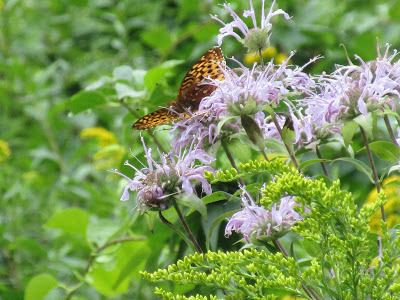
Photos taken on our recent stay in Berkshire County, in western Massachusetts. With hikes in sunny wildflower meadows, silent greenwoods; under billowing clouds, along brooks -- in Jug End in South Egremont, at Tyringham Cobble, though Stevens Glen, up Hancock hills where the Shakers once lived and dammed a flowing brook for power... also through Bullard Wood and Gould Meadow, bordered by the Stockbridge Bowl and Tanglewood... and many miles to go this autumn.
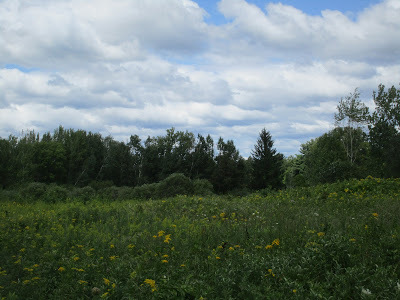
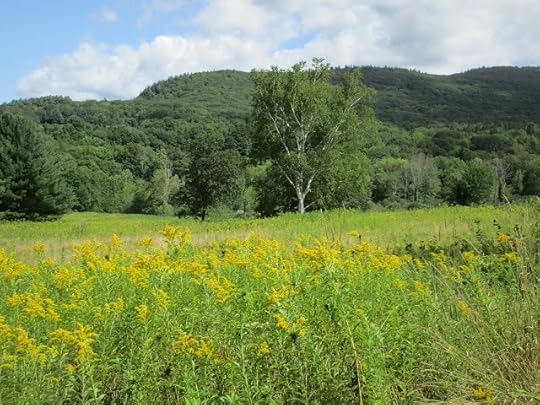
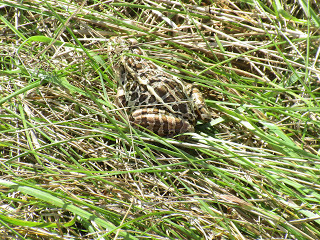
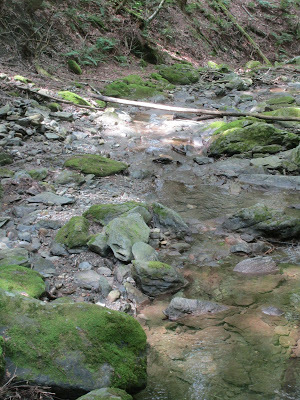 Too Big for the Camera: Jug End, Tyringham, Stevens Glen
Too Big for the Camera: Jug End, Tyringham, Stevens Glen These are the far fieldsWe drive, now, to find themNo plough has cleaved their earth for generations,the croplands and pastures of a nearly forgotten civilization,
as if aliens had once farmed these lands,
imposing upon them the annual revolution of the blade and the hoe,
a visceral survival of coaxing food from the earth, feeding your beasts in the fields,
so they would feed you.
Our money has moved on, and we have followed
No more cash on the barrel-head,
greenbacks no longer wave from the seed head,
those once wavy fingers of Cornus,
the foundational green divinity of a civilization
that was once our own
Earth restored to earth, left fallow, abandoned to the peculiar beauties of elements cruel to human flesh, the cold love pressed upon living thingsNow we turn earth and water to the playgrounds of cities, abandon the vine and tangle, the thrust of stem and spike and flower,the old romp with Ceres in the unregulated market place of fertilization
So they return, old world incarnations of the pastoral and hay field
uncultivated by human hand, they bloom yellow, white, the pinkish blue of honey-bee balm suddenly everywhere this season, a harvest of itself;lacy tops, yellow-headed circles of transfigured solar—All his primal energy unrestrained by human geometries, evolution in confusion
What do we see in you?Deep and distant Jug Head, or sunny Gould,Or the climbing barrow of Tyringham, cobbled from IceAge vintages surging with richly flowered necklaces of white and orange,corn blue, field flowers unknown to us, a native nirvanaCatnip for butterflies and bees grass-hoppering in the midday sun, feeding splendor for the swallows,flyover for the hawk,these massy estates of some wild pluming
We go only to gaze,
stroll in the mowin’ --
keep to the preservationists' paths, obeying the signs Eyes on the earth and all its splendid jewelry configurations of a greeny wealth gone wild
Published on September 02, 2019 22:36
August 16, 2019
The Garden of Lies: The Latest Attempt to Poison America's Legacy as "A Nation of Immigrants"
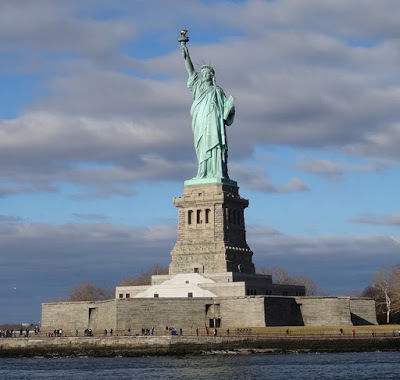 The moral abomination who currently occupies the oval office has done it again. He has appointed somebody to an important government position who hates the very service that his department has always provided for the betterment of the nation.
The moral abomination who currently occupies the oval office has done it again. He has appointed somebody to an important government position who hates the very service that his department has always provided for the betterment of the nation. What does his latest 'pick-a-stooge' appointment to high federal office--acting Director of Citizenship and Immigration Services Ken Cuccinelli -- fail to understand about "a nation of immigrants" and the history of this country's founding and subsequent growth, development, and astonishing success.
Or rather what doesn't he fail to understand?
According to the US Census Bureau, 2 percent of our country's population consists of Native Americans (6.6 million as of 2015). That means 98 percent of of census-counted Americans came from somewhere else -- i.e., we are (almost) all of immigrant stock.
In the service, however, not only of historical amnesia, but of his enabler's sadistic taste for punishing those in need, the new immigration services boss decided to rewrite Emma Lazarus's famous poem that celebrates the Statue of Liberty and concludes with the oft-quoted nation-building lines:
"Give me your tired, your poor,
Your huddled masses yearning to breathe free,
The wretched refuse of your teeming shore.
Send these, the homeless, tempest-tost to me,
I lift my lamp beside the golden door!"
But according to the new Tumpetty-puppet's rewrite, those lines should read: "Give me your tired and your poor, who can stand on their own two feet and who will not become a public charge."
New immigrant boss Cuccinelli's ignorant, racist assumption drew a quick rebuke from Pulitzer Prize winning journalist and author Sonia Nazario, who pointed out, correctly, "The reality is that immigrants who come here legally are no more likely to be on welfare than people who are born in this country. ... The reality is that immigrants who have come to this country, whether they are poor or rich, are what have made America great."
Let's look at some famous instances. The Pilgrims who arrived here from England and the Netherlands in 1620 could well fit the apt and stirringly eloquent description of the immigrant population in Lazarus's poem: "..your tired, your poor, Your huddled masses yearning to breathe free.."
Since Trump's appointees are famously ignorant of history or the mission of the agency they've been given stewardship of in order to further the occupant of the White House's nasty, small-minded prejudices, let's look at the history of how the United States came to be. Whose view of immigration is better supported by the facts -- that of Lazarus's beloved poem? Or Cuccinelli's Trump-twisted version?
The nation's most famous European immigrants, the Pilgrims, were surely 'tired' after the hardships of a 17th century Atlantic voyage. They were 'poor' after spending whatever funds they had assembled on commissioning and provisioning a ship for the voyage. They had "huddled" beneath decks of their not terribly ocean-worthy vessel during the storms of the North Atlantic. And I'm sure they were yearning for a breath of fresh air, though they would have been happier about the New World's open-air accommodations if they hadn't arrived in winter. And they were literally a match for another of the famous poem's depictions: "homeless" and "tempest-tost."
As for 'standing on their own two feet,' many of them could barely walk off the ship. Some remained on it all winter. The group's survivors soon received valuable assistance from Plymouth's indigenous residents who, despite suffering terrible losses of their own from plague germs brought by prior contacts with Europeans, taught the new arrivals what crops to grow and how to grow them. And at that famous harvest-time "first Thanksgiving," it was the Indians who supplied most of the food.
In the wake of the first scattered immigrant societies in New England, New York, and Virginia, migrants from England, Scotland, Holland, Germany and other European countries founded the colonies from which grew the nation that became known as the United States of America. Some of them arrived with sufficient wealth to 'stand on their own feet' economically, perhaps after the sea-sickness wore off. Many others relied on the assistance provided by religious or national communities already here.
No 'immigrant policies' decided whether they would be granted admittance or not. They took their chances, risked their lives, in coming to a foreign shore. Some prospered; some faltered. But you certainly could not predict who would or would not become valuable contributors to society based on what was found, or not found, in their pockets on the day of their arrival.
The immigration policy apparently favored by Trump and his latest mean-spirited acolyte -- requiring new immigrants to demonstrate that they had the means to support themselves in their new country; a requirement generally known as "a means test" -- flies in the face of history.
Unlike the spoiled occupant of the White House, who was born rich and therefore assumes only rich people are valuable members of society, the majority of of this nation's most important, famous, creative, patriotic and otherwise valuable contributors would not have passed "a means test" when they arrived in America.
If a means test were applied to immigrants in those early days, would David Carnegie, a poor Scottish immigrant, have been allowed off the boat? JP Morgan was a 19th century financial tycoon, railroad baron, and symbol of wealth in the first Gilded Age (we're unhappily enduring the second one right now), but his early immigrant ancestor was just another soldier of fortune when he arrived from Wales in 1636. Ben Franklin's ancestors were 17th century English Puritans seeking religious freedom in a new land; they did not arrive with full purses.
Henry Knox, whose brilliant military leadership was responsible for driving the British out of Boston in 1776 and who later became George Washington's Secretary of War, was the descendant of Ulster immigrants. His father was a ship builder who came to Boston in the early 18th century, becausehe went broke back at home. Not likely, then, to pass a means test. But America's Revolutionary War might have played out differently without his son's contribution.
So many of America's essential nation builders descended from people who not would not have been permitted to enter this country if arriving with a sufficient nest egg were the criterion for entrance. Andrew Jackson, a scourge to Native Americans but an apostle of universal male suffrage -- back when that goal was the definition of democracy -- grew up in poverty. Abraham Lincoln, still the greatest of the nation's public servants, grew up in legendarily humble circumstances. Lyndon Johnson, whose political leadership assured the country's only meaningful Civil Rights legislation, also grew up poor.
Delving deeper, among the major 19th and early 20th century immigrant groups, the migrants from an economically devastated Ireland, to take a justly celebrated example, would not have passed a means test. A few decades later the descendants of those who endured poverty on both sides of the Atlantic, were serving as mayors and governors of major cities in states such as New York and Boston. John F. Kennedy may have grown up in wealthy circumstances, but his ancestors did not.
The same general truth applies to the Italian, Jewish, Russian, Polish, Hungarian, Slavic and other Eastern European immigrants who migrated here in the second great wave of immigration from 1880 to 1920. Both farm prices and the fishing industry were collapsing in southern Italy, when millions of Italians arrived on these shoes. Jews were escaping violent repression in Russia and Poland and other European countries.
Chinese immigrants came here -- like their European counterparts -- fleeing famine and seeking work. They found it digging the rail beds for the first continental railroad, as the Irish before them dug the Erie Canal and worked on the early East Coast railroads.
Political and economic oppression, the absence of opportunity, drove the poor and the vulnerable from unfriendly societies to the country that most singularly represented the availability of freedom and opportunity. People do not leave their homes on a whim but because they are driven by poverty, political oppression, and in many cases by clear existential threats to their future survival.
Beneath the Statue of Liberty, whose meaning was so lastingly interpreted by Lazarus's poem, New York City's Ellis Island received millions of newcomers who would not have passed "a means test" to prove that they could 'stand on their feet' upon arrival.
Irving Berlin, a Russian Jewish Immigrant, arrived on Ellis Island in 1893. Where would popular American music be without “White Christmas” and “God Bless America,” his 19 Broadway shows, and many movie scores?
Ettore Boiardi arrived from his home town of Piacenza, Italy and found work at New York’s Plaza Hotel in 1914. He eventually pioneered the product line of canned Italian pasta and sauces through his company known as "Chef Boy-ar-dee."
Mother Cabrini arrived at Ellis Island in 1894, sent by the Pope to better the lives of poor Italian immigrants, and succeeded in establishing orphanages, schools and hospitals across the country. It was not because she brought bags of money with her. Miracles happen when a society permits talent, creativity, intelligence, diligence -- and, perhaps, faith -- to go to work.
That society does not at first demand, 'Let me see your bank account.'
Albert Einstein left Germany and immigrated to the United States in 1921. He wasn't there for the Nazis; he was here for Roosevelt.
Who will be there for us in the future, if the rules of the Abominable Regime hold sway over American immigration policy, as they have already flouted all human decency on the Southern Border?
We should take care to remember the poem, Emma Lazarus's poem, the way she wrote it, and bury the Trump-dummy's revision with the scorn it deserves
The poem is an icon of American values. Those values are what makes America 'great' -- not its bombs or the billions piled up by the corporate oligarchs. The market value of Amazon or Facebook -- or Trump Enterprises, if in fact that entity has any value -- are worth little or nothing in the long run. Material fortunes bloom, and disappear.
The words, and meanings, of Emma Lazarus's poem are worth everything. We forget that at our peril.
If the current regime of the small-minded hater-in-charge holds sway much longer, the good ol' USA runs the risk of becoming just another authoritarian corporate state. Where 'the means' matter, and the meanings don't -- like Russia, or China, or North Korea or Saudi Arabia.
Who'd want to immigrate there?
Published on August 16, 2019 08:54
July 28, 2019
In the Garden of the Creators, The Gods Speak in Thunder
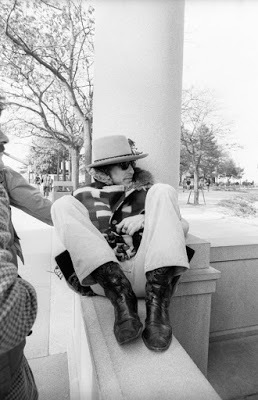 It's 1975 in America. Anybody want to go back to that zeitgeist? I wouldn't think so... but then again, considering where we are now.
It's 1975 in America. Anybody want to go back to that zeitgeist? I wouldn't think so... but then again, considering where we are now. According to a recent story in the Old Colony Memorial (my journalistic alma mater) the 'business plan' for Bob Dylan's Rolling Thunder Revue tour was to promote the release of the now third or fourth incarnation superstar's new album "Desire." In a piece of local history insufficiently celebrated, a rarity for Plymouth, Dylan chose to perform the tour's first concerts in the town's Memorial Hall, an aging and semi-dilapidated World War I era auditorium, on Oct. 30 and 31. According to the newspaper story, also published in the Patriot Ledger, tour promoters rented an oceanfront home (for a visiting 'celebrity') and engaged the services of a housekeeper-cook. But Dylan was a reclusive vegan. He stayed in the tour van and didn't eat the food cooked for him. According to the story's sources, Dylan was "fond of the area," Plymouth and Cape Cod. Dylan and his band -- a smaller number than the large and divers entourage that would join the tour in the succeeding months -- rehearsed in Sea Crest Motel in Falmouth, surprising that establishment's regular Bingo session. And, perhaps best of all for the local market, the paper found a photo of Dylan leaning on round support column at Plymouth Rock. The Rolling Thunder tour is the subject of feature-length documentary by Martin Scorsese -- that debuted earlier this summer on Netflix. Which, in my humble opinion, is currently the best thing on Netflix or any screen anywhere. If you're not old enough to have experienced the letdown of the 70s after the wild, norms-smashing promises of the 60s when the times truly were changing, it's hard to appreciate the tour's premise. So, for context, in the mid-70s New York City was bankrupt and cities were everywhere failing. Crime was up, and a criminal was President -- oh, maybe today's audiences can understand that. When the Rolling Thunder Revue opened -- what today would be called a 'soft' opening in a hall in Plymouth -- the documentary (full title: "Rolling Thunder Revue: A Bob Dylan Story by Martin Scorsese") shows a guy on Court Street being handed a leaflet about the concert and asking in a puzzled voice, "Why does he want to come to a little place like this?" The film also has a brief clip of Dylan and companions visiting the then-tourist attraction Wax Museum and contemplating a wax JFK. A wax LBJ. Plymouth was the sticks back then; it's practically a metropolis today. America's big cities have rebounded considerably as well; that's where the money lives now. America and the pre-digital world were part of a different universe a half century ago. And into that empty space between then and now, a unique strain of artistic genius could find a space to imagine a way on. I'm sorry I missed being in the seats for one of the tour's many live, small-theater performances. (I was living in Cambridge then.) But Martin Scorsese's magnificent documentary makes the thunder of the mind roll on again.
Some enduring impressions: Dylan wearing hat with an opulent flower, a dandyish fashion from who knows when, and singing "Hey Mister Tambourine Man." The film cuts away to a clip of Richard Nixon, his blast-from-the-past deep voice celebrating the promise of the 'American dream' as the theme for the bicentennial. Would that dream, perhaps, consist of ending the War in Vietnam?... Dylan talking about why he invited the playwright and novelist Sam Shepard to travel with the ever-expanding revue tour. Shepard "brought a knowledge of the underworld," he says. "He communed with the dead."
An older Dylan expressing the need for a 'new' birth of hope in America, offering, for example,"people lost a sense of connection. Two people tried to shoot the President in one month." Wow. I didn't know he cared. Allen Ginsberg, an immortal voice of his generation, explaining the impulse for the tour's unorthodox collection of voices, performers, and hangers-on: "to show how beautiful we can be [as a country] by showing how beautiful we are." (A statement that NY Times reviewer Manohla Dargis misquoted as "showing how beautiful he [Dylan] is...," in order to belittle both Dylan and Ginsberg. It a good think neither Dylan nor the filmmakers are litigious.) A more contemporary Dylan (interviewed for the Scorsese's film) reveals his literary knowledge in quoting Ginsberg's famous line from Howl: "I saw the best minds of my generation destroyed by drugs..." In another cut from the contemporary interview, an aged Dylan reveals a grouchy old man persona when asked about the inspiration for the Rolling Thunder tour: "I don't remember a thing about the Rolling Thunder tour. .. It was 40 years ago. I wasn't even born then." Which is to say, quite truly, that he was a different person back then in his thirties. We all were. Because on the screen we see Dylan prancing on stage in white face paint singing "to dance beneath the diamond sky..." The thing is, as perceptive students of Dylan's Nobel-winning career have pointed out, his singing and stage performances captured by film of the tour were never better. Wholly committed, passionate, loose-bodied, comfortable in his skin (at least on stage), exhibiting a willingness to interact with the audience that his younger, pricklier self never showed.
Dylan -- an older Dylan in the Scorsese interviewers -- offering the interviewer the film's money quote: "Life isn't about finding yourself... Life is about creating yourself." We see this self-creation in action. Dylan on stage performing, singing duets, exchanging leads with band members, among them the incredibly well-suited electric fiddle player Scarlet Rivera, a name that was unfamiliar to me. Her presence provides a link to the face paint that Dylan, and some others wore, on stage. Rivera sometimes played with the early 70s rock act Kiss, who impressed me as too atrociously one-dimensional to listen to. But Kiss members grease-painted and dressed like clowns on stage. Dylan face-painted in the tradition of the commedia dell'arte, those traveling players with roots in the Middle Ages, who served as a precedent and philosophical anchor for his Rolling Thunder traveling 'revu' -- never simply a headliner plus openers -- and his determined preference for smaller halls. Not a stadium tour. The audience was close; it was in his face. And what they saw on Dylan's face was a mask. Leading to this wonderfully apt quote, again from the current-day interview: "When somebody’s wearing a mask, he’s going to tell the truth. When he’s not wearing a mask, it’s highly unlikely.”
Dylan of course never wears a mask in his often visibly reluctant interviews. Or, perhaps, those masks are invisible. Rivera's contribution figures heavily in performances with Dylan of songs I never fully appreciated, including "One More Coffee for the Road" and "Isis."
Baez, interviewed for the 1975-76 tour film that provides images for Scorsese's new film, recalls her touring with Dylan in the 60s. She recalls the hotel room where he wrote "The Lonesome Death of Hattie Carroll." The film also includes strong stage performances by other major voices of the time. The energy is catching Joni Mitchell sings her song "Coyote." In the film Roger McGuinn says that she wrote the song "about this tour and on this tour and for this tour.”
Joan Baez duets with Dylan, who is seen in a tour-time interview responding to a question this way: "Joan Baez and me, we can sing any song." And in fact, better than in any other filmed performance, the film shows what a great singer Dylan is. Not just a guy with a weird voice and an attitude. And what a great musician. The trick is not just writing the lyrics. It's finding the music that turns them into magic, lights their fire. And then the stage performance that sells them. His lyric says: "your loyalty is not for me, but to the stars above." Who else has written that? And when you hear the line sung, chills go through you. On stage in Rolling Thunder, Dylan sings at a fast pace, at times in the topical songs with a barely contained rage that goes off in you mind like an extended explosion. He knows you know a a song such as "The Lonesome Death of Hattie Carroll" and where it's going, so instead of the coldly ironic build-up to the devastating conclusion, he screams the song out like a horrified witness statement. Barely contained passion -- matching the blunt anger of the lyrics -- also characterizes of the later 'protest' ballad "Hurricane," another tale of unspeakable injustice committed against someone guilty of breathing while black. Other interviewees comment on Dylan's "energy" both on and off stage. The energy was "rolling thunder." He was remaking himself, just as he remakes the songs in these performances. He knew how to do it. He had done it before. He would do it again. If you've ever had any interest in one of the major artists of our time, you have to see this film.
Published on July 28, 2019 13:25
July 15, 2019
The Garden of the Seasons: Daylilies, Natural Drives, and the Delights of Midsummer

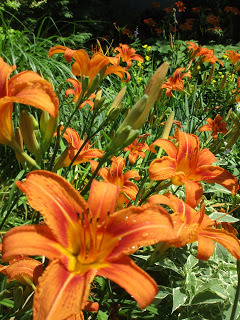

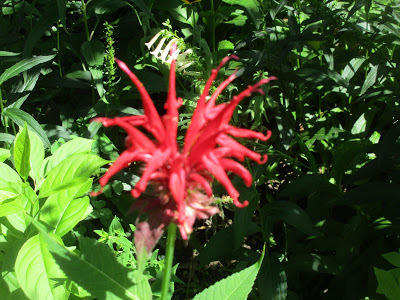 If you grow daylilies the first couple weeks of July will be a kind of Christmas in July. Most, though far from all, daylilies bloom in this mid-summer period. A time I both love, and wait for each year, but also experience with a kind of anticipated regret, knowing that each passing day -- according to the absolute law of this hard-blooming species -- means that I will lose the previous day's entire cohort of beautiful warriors in the battle to bring color and the rare, fundamentally indescribable -- not for want of trying -- pleasure of living things that succeed on planet earth, century after century, millennium after millennium, simply by making themselves appear "beautiful" to species of an entirely different order of being!
If you grow daylilies the first couple weeks of July will be a kind of Christmas in July. Most, though far from all, daylilies bloom in this mid-summer period. A time I both love, and wait for each year, but also experience with a kind of anticipated regret, knowing that each passing day -- according to the absolute law of this hard-blooming species -- means that I will lose the previous day's entire cohort of beautiful warriors in the battle to bring color and the rare, fundamentally indescribable -- not for want of trying -- pleasure of living things that succeed on planet earth, century after century, millennium after millennium, simply by making themselves appear "beautiful" to species of an entirely different order of being! Flowering green plants: they spread their seed, disseminate the means to perpetuate the species, perform in effect the same responsibility 'higher' animals such as ourselves do when we mate, reproduce, and guard our offspring with our lives, doing everything in out power to protect and further their existence. We keep our species going, individual by individual, generation by generation, obeying a command of our deepest nature. The example of flowering plants suggests that beauty, growth, the urge to survive, the instincts by which to achieve that goal are all means toward achieving the goal and end of any single living thing -- to perpetuate life itself.
 If flowering plants have a religion -- this is it. And they express it so beautifully. This is why, perhaps, some of us get wrapped up in the success, or absence thereof, of so many of the plants we spend the summer with. We desire to know how well some of our favorites -- the daylilies, say -- are going to perform in a given season. It excites me, pleases me, to notice that the most common member of this family, the native orange-blooming 'ditch lily' has spread its seed to some corner of the garden where it hasn't appeared before.
If flowering plants have a religion -- this is it. And they express it so beautifully. This is why, perhaps, some of us get wrapped up in the success, or absence thereof, of so many of the plants we spend the summer with. We desire to know how well some of our favorites -- the daylilies, say -- are going to perform in a given season. It excites me, pleases me, to notice that the most common member of this family, the native orange-blooming 'ditch lily' has spread its seed to some corner of the garden where it hasn't appeared before.  Plants can 'spread out' or disseminate, or send new colonies, or new family members, perhaps, into different patches of ground in our flower garden because this is a garden, a space, without fixed dominions. Natural selection is given room to operate here. Things grow, expand, march forth, occupy territory. Some unfortunately decline in numbers, and even disappear. I try to protect the smaller and more vulnerable species, but I can't keep track of everyone.
Plants can 'spread out' or disseminate, or send new colonies, or new family members, perhaps, into different patches of ground in our flower garden because this is a garden, a space, without fixed dominions. Natural selection is given room to operate here. Things grow, expand, march forth, occupy territory. Some unfortunately decline in numbers, and even disappear. I try to protect the smaller and more vulnerable species, but I can't keep track of everyone.  Too much is going on. I like it that way. I am a player in the arrangement of species here, but not a dictator. I don't have the time, or taste for that kind of role. This is a living kingdom. When the orange daylilies jump over to a place near the white fence that once was occupied by what -- I don't think I remember: all various plants species are all simply playing by the same rules. Blossom, flower, send forth your seed. Go forth and multiply.
Too much is going on. I like it that way. I am a player in the arrangement of species here, but not a dictator. I don't have the time, or taste for that kind of role. This is a living kingdom. When the orange daylilies jump over to a place near the white fence that once was occupied by what -- I don't think I remember: all various plants species are all simply playing by the same rules. Blossom, flower, send forth your seed. Go forth and multiply. Plants in this garden, as plants have everywhere this summer, have multiplied with enthusiasm. They are doing their thing. They are shooting out their blossoms, firing the flower and fruit of their nature. They are reaching for the sun.
Plants in this garden, as plants have everywhere this summer, have multiplied with enthusiasm. They are doing their thing. They are shooting out their blossoms, firing the flower and fruit of their nature. They are reaching for the sun. 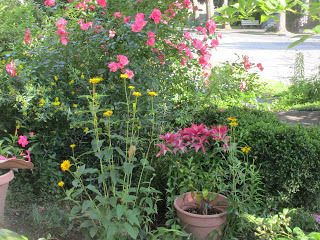 I salute them. I exult in their effort, their vitality, their strength, their beauty. I am sorry only that the fireworks cannot last. Every day I admire their work, and realize that they (and we) are one day nearer to the end of things in this glorious season.
I salute them. I exult in their effort, their vitality, their strength, their beauty. I am sorry only that the fireworks cannot last. Every day I admire their work, and realize that they (and we) are one day nearer to the end of things in this glorious season. Reach for the skies, people. I'm with you in spirit.
Published on July 15, 2019 21:18
July 2, 2019
In July's Verse-Virtual.com, a Little 'Canyon Music' Recalling an Unexpected Bonus from our Recent Visit to Canyon Country
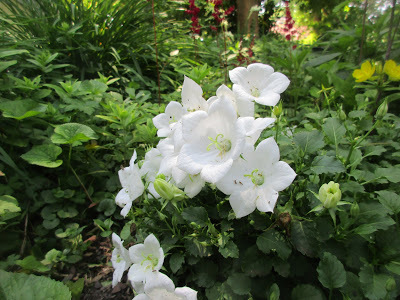 July may be favorite month -- if it isn't June, or May. (Or maybe August or September... and you can make a wonderful case for October...)
July may be favorite month -- if it isn't June, or May. (Or maybe August or September... and you can make a wonderful case for October...)In my poems in this month's Verse-Virtual.com, the online poetry magazine that publishes a full new issue every month, I pay a lingering revisit to the wonders of the Grand Canyon National Park. My poem "A Canon to the Canyons"offers a song of praise to an unexpected bonus from our recent Western adventure -- a complete holiday from any reference to our current National Disaster.
You know what I mean? Shhh! Not a word. Here are the first 2 stanzas of the poem.
A Canon to the Canyons
Introit: The canyons are beautiful
the canyons are awesome and full
of folk, visitors all, always cheery, never a pall
It was a fine vacation --
a vacation from the nation!
Refrain: And nobody talked about Trump!
not a mention, or a tension, or a gibe for your attention,
or a rant, or a cant, or a guy you'd like to plant
(will he grow? will he die? turn his roots up to the sky?)
And nobody talked about Trump!
For the entire poem see
https://www.verse-virtual.com/robert-knox-2019-july.html
I also contributed poem inspired, in part, by music. Actually, it was the title of an instrumental song performed by Rachel Grimes, titled "Earthly Heaven," that got me going. Here's the beginning of that poem, mixing a sense of the spiritual calm that comes from a satisfying yoga class, with a little something more "earthly."
Earthly Heaven
On an eastbound journey...
just back from yoga class,
recalling the three 'R's' --
Are you mindful?
Are you in the moment?
Are you checking out anyone else's bod?
To read he rest of this poem, see
https://www.verse-virtual.com/robert-knox-2019-july.html
To find poems by all the contributors to the July 2019 Verse-Virtual, see
https://www.verse-virtual.com/poems-and-articles.html
Published on July 02, 2019 21:43
June 24, 2019
The Garden of Verse: The American "Dreamtime" in June's Verse-Virtual
 We all have parallel lives, that overtake us in our sleep. We call them dreams. As irrational and absurd as our dreams may appear, we sense some overlap between our 'real' waking life and dreams. As Prospero's memorable reflection on this theme in "The Tempest" tells us:
We all have parallel lives, that overtake us in our sleep. We call them dreams. As irrational and absurd as our dreams may appear, we sense some overlap between our 'real' waking life and dreams. As Prospero's memorable reflection on this theme in "The Tempest" tells us: "we are such stuffas dreams are made on, and our little lifeis rounded with a sleep." Some poems in June's Verse-Virtual.com, the online poetry journal, deal with 'dream-like' aspects of our wide-awake lives. In Donald Krieger's hair-raising poem "Dream Street," the speaker gets home from his job in emergency medicine to"sleep with eyes wide open: a child shrieking on a hospital gurney,
her spine flayed and straightened,
the smell of burning in my hair..." The poem's last line, "never dreaming what will come next" reminds us of the many nuances of that busy word "dream." A tough, but marvelous poem.
Alan Walowitz's droll conflation of dreams, comedy and self-mockery, "Dream of the Standup Poet," he tells us, has this origin: "I jotted down this particular dream verbatim one morning when I awoke feeling more mean-spirited and self-pitying than usual." The poem's twisty, dream-like logic conflates poet and comic, self-doubt and aggression, beginning with the 'stand-up poet' s pre-emptive attack on a "heckler":"Poseur, Scrivener, Amanuensis, Lightweight."
Stand-up comics, rather than poets, are expected to face hecklers, and this dreamlike role-reversal plays through the amusing, on-target business that follows. The poem keeps doubling back on itself, the way our own dreams undercut our sleeping brain's ever-failing attempts to 'make sense' of the plot. All in all, a stand-up performance, with a surprising punch-line at the end. Donna Hilbert's superb "One Night, Three Dreams" also digs into the mechanics of the bizarro world of dreams, beginning with an opening advisory: "If you are having trouble with this dream, please contact our dream technician." Oh, if only. Here again we find ourselves shoved onto the stage of an anxiety dream: "Though
my glasses slip from the perch of my nose
and I have not rehearsed, I plod on.
No one thinks my jokes are funny
or my examples apt." Sound familiar? I am reminded of a famous Dylan line about nuclear annihilation, "Everybody's havin' them dreams." The following stanzas, an inexplicable visit to "Falcon Day" and the dreamer's guest-shot appearance at the communion rail, confirm the essential 'lostness' of such dreams: We know we're being told something, but we can't put our finger on what. "Lives of the Dead," poet Judy Kronenfeld tells us, was "elaborated and heightened from the feeling-tone" of a dream:"Alive in my dream, and serene,
they sit in our old 40-watt-
dim Bronx kitchen on the lollipop red
dinette set leatherette chairs." Dreams not only access the surreal, they are time lords. Able, as in this warm-hearted and mostly jolly romp, to take us back into some mixed-up version of the past. The couple play a game of scrabble, "though neither dad nor mom could spell." Meanwhile the poem's speaker has been robbed of the "grocery money" by someone "brandishing an AK-47." Nevertheless the game goes on, "both of them comfortable and anarchic in their little pocket of moored time." The superb phrase "moored time" images for us the eternal availability, in some part of our minds or souls, of all our lived experience. Robert Wexelblatt's poem "Daydream" plays on another aspect of the "dream" -- dream as longing. "If I could play the piano and speak Italian
I don’t think I’d do anything else, not
if I had Bill Evans’ hands and Mastroianni’s voice." Beyond the stylish imagery, the poem is very satisfying formally, wiggling its opening line through a half-dozen three-line stanzas until it becomes the poem's closing line. The texture of poem has charm too, with its references to composers and quotes in Italian and its classical definition of cool: "All my words would be music, my chords poems,"
Kate Sontag's "Merwin’s Doors: In Dream & Elegy" speaks to an elemental connection between dreams and poetry. The poem cites the mind-opening example of the "doors" of perception that the poet found in the work of the recently deceased poet W.S. Merwin. "you had so many doors
I walked through
a mere ghost of a girl
lost at sea hearing
the odd formality
of your foghorn
drawing me closer" The poem follows the rich imagery of 'doors' to this satisfying conclusion:"In dreams all doors are open
to the one who is dreaming..."
I also admired in June's Verse-Virtual Tricia Knoll's three lovely, free-spirited poems of fresh air and outdoorsy, spring-like imagery, especially this praise-song to the life of trees, "I Want to Write." Great lines throughout. To cite just a few:"how quaking aspen memorize
the end rhymes of creation myths
how dance classes for willow branches
warm up by sleeping beside the motherI want to write the prayer winds
that fan the ginkgo’s gold" The poem makes me ask, 'why am I not outdoors climbing mountains or hiking woodland paths?' Maybe that's the message.
Steve Keptar's "Night in June" carries a similar free-flowing energy, with its strong response to the wonders of the cosmos that's out there all the time, and then sometimes our senses and our minds catch fire from its immensity and we burn as well -- "their eyes on fire and their tongues
preserved in ice." It's a poem of seeing the world with fresh senses, a landscape "where hills rose like teeth from the red earth." His poem "Where Was Your Father Born?" begins with one of those revealing quotes from the anti-poet in the oval office concerning the birthplace of one's father. The title question provokes a marvelous riff on birth places from the exotic (though true) -- "Moravia, in the Austro-Hungarian Empire" -- to the familiar ("California, in the Plieto Hills near the San Joaquin Valley"); and then to the mythic realm, with a brief dialogue on the birth of the single-dipped Achilles. In poems, as in dreams, we are born in many places.
Published on June 24, 2019 15:29
June 17, 2019
The Garden of History: Paying the Costs of 'Getting On'
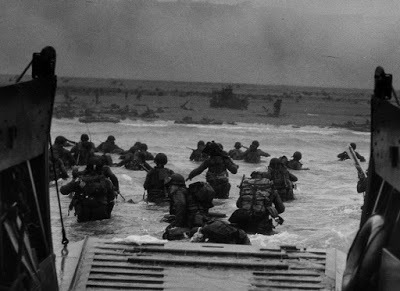 My father, a World War II veteran, had the good fortune to miss the D-Day invasion. All his good fortune, as I am well aware, accrued to myself, my brother and sister, and all the others whom his life subsequently touched.
My father, a World War II veteran, had the good fortune to miss the D-Day invasion. All his good fortune, as I am well aware, accrued to myself, my brother and sister, and all the others whom his life subsequently touched. This simple fact of my own fortunate existence is brought home to me at each commemoration of the D-Day landing at Normandy, France, and of the other momentous dates that followed in the bloody campaign of Europe's liberation from Nazi control. Many are the ways produced by natural and human history to shorten lives before their natural span, but taking part in the justly famous invasion of June 6, 1944 was surely one the most conspicuous of these. As commentators pointed out this year, the world will probably never see its like again.
And, as historian David Christopher pointed out in the first sentence of his recent moving and informative essay on D-Day in the New York Times: "Most of the men in the first wave never stood a chance."
And as other deeply reflective accounts of the deadly start of the great invasion pointed out, the companies and battalions of infantry chosen for this first wave knew that they had been chosen to be human sacrifices to a battle plan that required a frontal assault on fixed defenses long in preparation. Still, these men climbed out of their landing craft and slogged toward their deaths.
Here is Christopher's account of those moments of the invasion:
"Concentrated in concrete pill boxes, nearly 2,000 German defenders lay in wait. The landing ramps slapped down into the surf, and a catastrophic hail of gun fire erupted from the bluffs. The ensuing slaughter was merciless."
The enduring courage of soldiers facing the strong possibility of violent extinction is one of the sad miracles of human existence. War is nothing without it.
The best, and best known, of American correspondents reporting the Second World War to the homefront, Ernie Pyle detailed the deadly intensity of Germany's defensive wall on the Normandy beaches: concrete walls, immense ditches, barbed wire, mines, big guns, hidden machine gun nests, and many armed veteran infantrymen.
And still, Pyle pointed out, after paying the cruel price exacted by such well prepared defenses, "we got on."
As Christopher points out in his piece in the Times, Pyle, who was on the beach by the second day, also wrote very frankly about the cost of the battle and the heroism the soldiers had displayed. The bodies he discovered sleeping in the sand and floating in the water would not wake up to celebrate a hard-won victory.
A current source reports this accounting for that first-day's fighting: 4,400 men died on the Allied side; 1,000 German deaths; civilian casualties estimated at 3,000.
And that was only the first of many deadly days to follow. Pyle continued to provide readers back home with concrete accounts of the conditions of battle and the cruel costs of the war in France. Though Allied armies advanced, the costs mounted steadily in a campaign that lasted almost a year before the liberation of Paris, the recapture of the remainder of France, the breaching of the German border, and eventually the German surrender on V-E day in May of 1945. Before that termination was reached, Pyle announced to his readers that he was leaving France: "I've had it... I've had all I can take."
All of this has a personal resonance for me, as it must for many Americans.
My father, Alva J. Knox, missed being part of that invasion and the costly slog to victory on the Western front, even though he had enlisted in the US Army in 1942. He wore corrective lenses and by Army standards then his vision wasn't judged strong enough to place him in a combat unit. Instead he was given the job of helping to process other recruits, from training to unit assignment. Then, some time in 1944, as the war persisted, demanding more and more soldiers for larger and larger armies, the US Army lowered some of its physical standards and concluded that someone with Dad's vision could be assigned to a combat unit after all.
His regiment was trained for combat and sent to England, to be prepared there for transport to the front lines.
By this time, late in the year 1944, the summer invasion of northern France had taken place and the Allied armies had driven deep into the country. But when bad weather grounded their air force, depriving the Allies of a major advantage, German forces launched the counterattack that would lead famously to the Battle of the Bulge.
As that battle raged, Dad's regiment was loaded onto three transport vessels to cross the English Channel and join the armies battling in France.
Then a cruel fate intervened. While Allied naval forces believed they had eliminated the German U-boat threat by this late date, apparently one enemy submarine had escaped detection. It torpedoed and sank one of three transport vessels as the ship neared the French coast. Attempts at rescuing the men forced to abandon ship were stymied by poor communications and a lack of available help. It was New Year's Eve; coastal commanders were off at parties. And winter in the North Atlantic is a swift executioner; cold water, brutal weather. Almost no one survived the sinking.
The consequence, as my father pointed out to me -- he was in his late seventies then, and this was the only time he would ever at length about his wartime experiences -- was that his regiment was now judged undersized and a poor fit to commit to a raging battle. Instead of being sent to the front lines, the diminished regiment was sent to man the holding position around the "Nice Triangle" and pin down the German force that was still holding that city and its port for use by the German Navy.
In his understated manner, Dad pointed out that he had been lucky to escape two bullets: he was not on the ship that sank on that tragic night -- a disaster, as he also knew, the Army kept secret during the war: He showed me the newspaper clipping that reported this story after the was over. And he and his comrades were never sent into the raging, uncertain Battle of the Bulge.
Fortunate, indeed, were the surviving members of this unit not to be sent straight from a training base to a desperate battle. As I know from reading accounts of the war on the European front, fresh and inexperienced American forces tended to suffer high casualties in their first weeks of action. Apparently, it took some time and experience to learn to keep your head down, dig your foxholes deep, and be ever on the alert for signs of trouble.
As I said above, and as Dad implied (but felt no need to point out), my siblings and I were fortunate that our father was one of the veterans who returned home from the European Theater after the heavy fighting of the campaign of 1944-45. Sent to the South of France instead, his platoon encountered a German patrol on at least one occasion, when Dad fired his weapon and shot a rifle from the hands of a German soldier. The standard German made infantry rifle became a war souvenir, stored in the basement, and one of the touchstones of my youth.
The other, broader memory of Dad's war was his service in the Army of Occupation that remained in Europe for the most of the following year. His regiment was quartered in Salzburg, Austria, Mozart's birthplace. Dad showed me the programs from the concerts he attended during that time. And the copies of the GI newspaper that continued to be published then. I was in the newspaper business then, and admired the standards of composition, layout and cartooning these period pieces had been able to maintain.
I believe that my father fought in a war that -- when it knocked hard on the doorway of his own manhood -- had to be fought. The only good wars are those are prevented, but by 1942, it was too late to do anything but pay the terrible price demanded by the terrible circumstances of a world war raging in both Europe and Asia for the restoration of some form of international order and peace.
I honor his service and, again, recognize how fortunate my family is he survived. The cemeteries in Normandy and throughout France and the rest of Europe are eloquent testimony of the price humanity pays when disasters of our own making pull down the houses of friendship and justice.
I faced somewhat similar circumstances in my own youth, but the war that came my generation's way, in Vietnam, need never have taken place, and I stand by my decision to avoid taking part in it. My father was of a similar opinion -- at least in the matter of my possible participation in that war, and maintained a keen interest in my deferred draft status.
Wars -- my father's, and all others -- continue to disturb and intrigue me, as they have throughout my life. I can seldom pass up a story, or newspaper article, about one. It as if we are all survivors, connected by guilt and mere humanity to all those dead and heroic soldiers, to the unheroic ones as well -- those who ran from sound gunfire (as I can imagine myself doing) along with those who advanced bravely toward it.
Years ago I wrote a published story about my father that dwelled in part on his military career. And a poem about the terrible fate that befell a large part of his regiment on their way to join the bloody battles in France, which I read recently to an audience. D-Day was coming up, and people applauded.
But, obviously, the subject is not exhausted, and never will be. I have accepted and stand by my own choices. And I am grateful for the choices made by my father, and my uncles, that helped preserve a world worth living in for all of us. But I am desperately unhappy about contemporary America's apparent willingness to throw away the gifts that were so dearly purchased for us.
After so many millennia of human dominance on Earth, we have still to address the problem of how to live together without succumbing again, and again, to the communal madness of a vast internecine blood-letting.
I hope we get there. I hope the sacrifice of the fallen may someday prove a gift we are ready to accept.
Published on June 17, 2019 12:21
June 4, 2019
The Garden of Verse: Perchance to Dream
 The theme for this month's issue of Verse-Virtual, the online poetry journal, is dreams. For me, dreaming is an almost daily puzzle, sometimes with a power that wakes me up.
The theme for this month's issue of Verse-Virtual, the online poetry journal, is dreams. For me, dreaming is an almost daily puzzle, sometimes with a power that wakes me up. I wake up feeling that something important, or meaningful, or at least real is being dramatized -- however absurdly -- in those nightly transmissions from my subconscious mind that pull at my conscious mind for the first few moments of wakefulness. Then they go up in smoke when I try to "recall" them in the language of the waking mind.
So, a fertile subject for poetry, that literary genre that feeds on emotion and imagination. Dreams and the subconscious mind. Dreams and absurdity. Dreams and the way real problems, anxieties, changes and challenges get encoded into the surreal images of our unconscious mind.
In a poem titled He Dreams He Burns His Book, the only clearly recollected image taken from a dream is the one that appears in the first line: a large (and naked) man exiting a toilet -- a picture that certainly resounds of the unconscious...
My conscious mind -- imagination, fears, self-dialogue -- must take responsibility for the thoughts, words and jumble of ideas that follow in this poem. These ideas and images come from my obsession with a society, or civilization, drifting toward disaster -- this is not a dream I would like to understand as a prophecy.
Here's the first stanza of that poem, one of three of mine that appear in the June issue.
He Dreams He Burns His Book
A very large man emerges from the toilet
It's not his fault, we say
We all must give something up.
Not my chocolate, I protest,
huddling in the corner, the blanket pulled over my head
Thus I appear to strangers as a slumped mountain
covered with coarse, brown grass, begging
for somebody to take me down
As for the others
They survive on ants and mud-covered
acorns, unearthed by leased squirrels
Times were hard too, when I was a child,
Gramps says
You think this is bad?
We ate the toes of plague victims
Our pens skipped
And we coated our fingers in icicles
to have something to drink
...
You can find the rest of this poem, my other two, and poems by 28 other poets in the June issue of Verse-Virtual.
Here's the link:
https://www.verse-virtual.com/robert-knox-2019-june.html
Published on June 04, 2019 22:08
May 30, 2019
The Garden of Faraway Places: Stalking the Wonders of Canyon Country
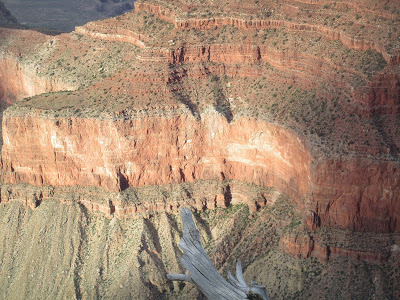 I will confess to feeling a little guilt over my blatant desire to rave about the wonders of Canyon Country in the great American Southwest.... with the clear implication that everyone who hasn't been there should drop whatever they're doing and rush out to distant parts to see these amazing spectacles for themselves. Fortunate are those who can take ten days in the latter part of May to fly to northern Arizona and pop in on the Grand Canyon, then work around a few mountains to visit the national parks in southern Utah -- those similar miracles of besotted nature given a couple of billion years to work on the landscaping and thus produce the landforms on view at Bryce Canyon and Zion national parks. They're on display, these natural Disney Lands of deep time and the river, of wind and rain, and of the tectonic forces that changed the face of the continent and drained the Western Ocean, lifted the land and exposed to the forces of erosion the hidden wealth of that 1.8 billion years of layered earth, rock, fossil and mineral making. People have jobs to do. Children to raise. Aging relatives to take care of. Still, when you do find yourself with the time and the means, there are many worse things you can expend those resources on than venturing many miles across a broad continent to take a good long gander at what Nature has wrought in particularly well-fashioned places such as these matchless canyon parks. In short, how wonderful, surpassing (and surprising) expectations our expedition to these national parks proved to be. Acting on guesswork, intuition, a guide book, and a bunch of websites, we pursued a plan to spend parts of three days on the Grand Canyon's south rim, two days on the north rim, a day's jaunt through the Arizona desert to see some 900-year-old Pueblo ruins; then up to Utah to spend a couple days each in Bryce Canyon and Zion National Park... And happily discovered there 'another America,' so utterly different from our home base here in New England; and so worthy of taking in with the senses and, perhaps, contemplating -- how does that line go? -- in 'tranquility'? So I'm back to tranquility, I guess, as long as I don't spend too much time with the newspaper or online. Anne and I took hundreds of photos, and I'm trying to whittle them down to a usable, keep-able size, while composing from notes a family-keepsake narrative of our days on the 'trails.'
I will confess to feeling a little guilt over my blatant desire to rave about the wonders of Canyon Country in the great American Southwest.... with the clear implication that everyone who hasn't been there should drop whatever they're doing and rush out to distant parts to see these amazing spectacles for themselves. Fortunate are those who can take ten days in the latter part of May to fly to northern Arizona and pop in on the Grand Canyon, then work around a few mountains to visit the national parks in southern Utah -- those similar miracles of besotted nature given a couple of billion years to work on the landscaping and thus produce the landforms on view at Bryce Canyon and Zion national parks. They're on display, these natural Disney Lands of deep time and the river, of wind and rain, and of the tectonic forces that changed the face of the continent and drained the Western Ocean, lifted the land and exposed to the forces of erosion the hidden wealth of that 1.8 billion years of layered earth, rock, fossil and mineral making. People have jobs to do. Children to raise. Aging relatives to take care of. Still, when you do find yourself with the time and the means, there are many worse things you can expend those resources on than venturing many miles across a broad continent to take a good long gander at what Nature has wrought in particularly well-fashioned places such as these matchless canyon parks. In short, how wonderful, surpassing (and surprising) expectations our expedition to these national parks proved to be. Acting on guesswork, intuition, a guide book, and a bunch of websites, we pursued a plan to spend parts of three days on the Grand Canyon's south rim, two days on the north rim, a day's jaunt through the Arizona desert to see some 900-year-old Pueblo ruins; then up to Utah to spend a couple days each in Bryce Canyon and Zion National Park... And happily discovered there 'another America,' so utterly different from our home base here in New England; and so worthy of taking in with the senses and, perhaps, contemplating -- how does that line go? -- in 'tranquility'? So I'm back to tranquility, I guess, as long as I don't spend too much time with the newspaper or online. Anne and I took hundreds of photos, and I'm trying to whittle them down to a usable, keep-able size, while composing from notes a family-keepsake narrative of our days on the 'trails.'Some high points and challenges:
First Peek at the Grand Canyon,
South Rim
Our first flight, the long one, takes us from Boston to Phoenix, where the temp is 92 degrees. A second hop, all of 20 minutes, lands us to Flagstaff. There we rent a car and drive for an hour and a half or so up to the Canyon. Sunny most of the way, growing a little mixed-clouds as we approach. The park at last, and my 'senior card' gets us in free --a free pass! what a deal! . … From the Visitor Center it's a short walk over to the rim trail. It’s see-through metal-fenced. We see the upper reaches of the South face as we grow near --which are amazing -- and then close enough to the fence rail to see the whole wondrous Big Bang! façade and we’re in awe.
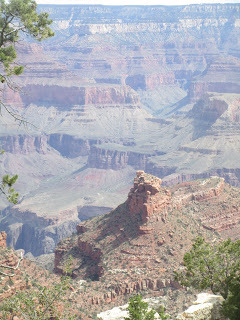 A religious experience right off the bat. Anne takes some photos on her phone. I don’t have my camera, it’s still in the car. I had no idea that the canyon rim was so close to the visiting center parking lot. Had no idea where 'it' was in this place for which we have journeyed almost 2,000 miles. We walk, among scores of tourists, like us, the recently arrived, all taking pics, selfies, herding kids, dragging dogs, climbing around the fence wherever they can to get closer. We walk out on some of the fenced in, lower points… and so shortly reach Manter’s Point, for its classic panorama: Stick your body out here, look all around you, left and right, and straight ahead. Wish like hell you had your camera.
A religious experience right off the bat. Anne takes some photos on her phone. I don’t have my camera, it’s still in the car. I had no idea that the canyon rim was so close to the visiting center parking lot. Had no idea where 'it' was in this place for which we have journeyed almost 2,000 miles. We walk, among scores of tourists, like us, the recently arrived, all taking pics, selfies, herding kids, dragging dogs, climbing around the fence wherever they can to get closer. We walk out on some of the fenced in, lower points… and so shortly reach Manter’s Point, for its classic panorama: Stick your body out here, look all around you, left and right, and straight ahead. Wish like hell you had your camera.Second Day at South Rim
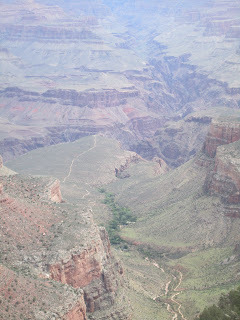
We hike along the rim trail, and up and down the far more challenging Bright Angel Trail until exhaustion claims me, and we take the shuttle bus back. We nap and, on waking, realize we are now in the 'golden hour' before sunset when, as a park ranger told us, the slanted light dazzles the array of color tones in Nature's great portrait of Earth, Rock, and Time that is the canyon wall. Clouds, some of them dark, cover the western sky, so we're not expecting much. But then we see gaps in the clouds permit arrows of radiance to pick out and illuminate segments of canyon wall. Camera in hand this time, I snap and snap and snap.
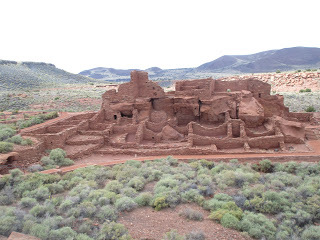
Wupatki Pueblo, a National Monument in the Arizona desert, was built during the 12th century CE and occupied as thriving agricultural village and trade center for about 150 years. The area was settled after a volcano isolated some farming communities. People return 100 years later, to find that they can plant corn in the recovering soil, the thin ash surface layer helping hold water in the earth. We see this ash, the still evident result of a geologic event taking place a millennium ago, covering swaths of surface land, hillsides, and some entire hills. Black hills endure here. The Pueblo people built the red-stone pueblo structures here from local stone and used clay for mortar. Some larger rocks were incorporated into the structure. A number of small rooms served as living quarters for connected families or ritually important tribal figures. As we explore the red-stone Pueblo, rain clouds gather on the mountainous horizon, while the sun remains strong overhead. The bigger force is the constant, high, gusty winds. Wind like that must dry the land and keep it dry. After a few minutes it starts to make me crazy with the desire to find shelter, or a wall to lean behind, any way to put something between me and the wind.
At Bryce Canyon National Park in Utah,
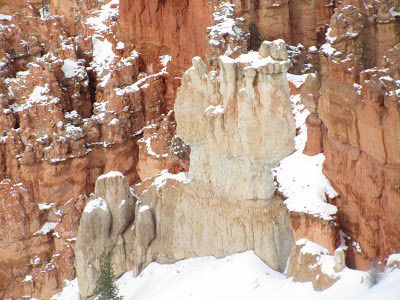 light snow begins falling shortly after we arrive at our lodging, which at first I regard as a great novelty – 'Gee,' I think, 'remember seeing snowflakes at Bryce at the end of May...' Snow grows stronger; next time I look the evergreen shrubs outside our window are showing that scenic wintry look. By morning six to eight inches have fallen, and slogging is hard on the park's open trails. Apparently most of the park is closed. The central ‘amphitheatre,’ however, where the views are stunning, is open to visitors. We drive to Sunset Point and join hundreds of variously dressed visitors picking their way along paths already turned to slush. The views at the outlook points are misted. We take the shuttle bus to Bryce Point, the crown of creation in this conspicuously showy park and find, with hundreds of others, that the view is almost all snow-fogged in. Half an hour ago, someone says, you could see everything. We go back to our lodging.
light snow begins falling shortly after we arrive at our lodging, which at first I regard as a great novelty – 'Gee,' I think, 'remember seeing snowflakes at Bryce at the end of May...' Snow grows stronger; next time I look the evergreen shrubs outside our window are showing that scenic wintry look. By morning six to eight inches have fallen, and slogging is hard on the park's open trails. Apparently most of the park is closed. The central ‘amphitheatre,’ however, where the views are stunning, is open to visitors. We drive to Sunset Point and join hundreds of variously dressed visitors picking their way along paths already turned to slush. The views at the outlook points are misted. We take the shuttle bus to Bryce Point, the crown of creation in this conspicuously showy park and find, with hundreds of others, that the view is almost all snow-fogged in. Half an hour ago, someone says, you could see everything. We go back to our lodging. In the late afternoon, however, when we return to the park the veil of mist has been removed and the view is clear to a horizon many miles away. The "hoodoos," the term given to these oddly humanoid figures of rounded red-stone columns (wearing their little snowcaps) line up for inspection.
Wednesday May 22, Zion National Park
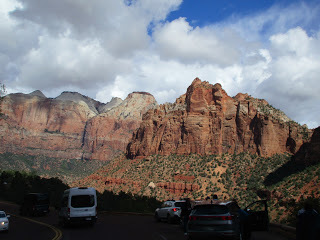 We get up and drive to the ‘east’ entrance through the 'famous' -- at least to park groupies -- ‘tunnel’ of switch backs and heavy traffic, cars pulling off the road wherever there’s any hint of space to gawk at the high walls, and cliffs, and multi-colored towers all round us, the road hair-pinning so frequently I'm afraid to take my eyes it to take in the truly astonishing mountain scenery through which mankind has chiseled this dramatic pass through god's damnedest country: these pinnacles, pyramids, domes, temples, cathedrals and fortresses of eroded rock -- as the painter who first shared them to the world at the St. Louis world fair (more than a century ago) most eloquently described them to a disbelieving public, saying in effect "you can't make this stuff up." I'm glad we went to see these miracles of time and mineral nature for ourselves. They are all really there.
We get up and drive to the ‘east’ entrance through the 'famous' -- at least to park groupies -- ‘tunnel’ of switch backs and heavy traffic, cars pulling off the road wherever there’s any hint of space to gawk at the high walls, and cliffs, and multi-colored towers all round us, the road hair-pinning so frequently I'm afraid to take my eyes it to take in the truly astonishing mountain scenery through which mankind has chiseled this dramatic pass through god's damnedest country: these pinnacles, pyramids, domes, temples, cathedrals and fortresses of eroded rock -- as the painter who first shared them to the world at the St. Louis world fair (more than a century ago) most eloquently described them to a disbelieving public, saying in effect "you can't make this stuff up." I'm glad we went to see these miracles of time and mineral nature for ourselves. They are all really there.
Published on May 30, 2019 20:12



